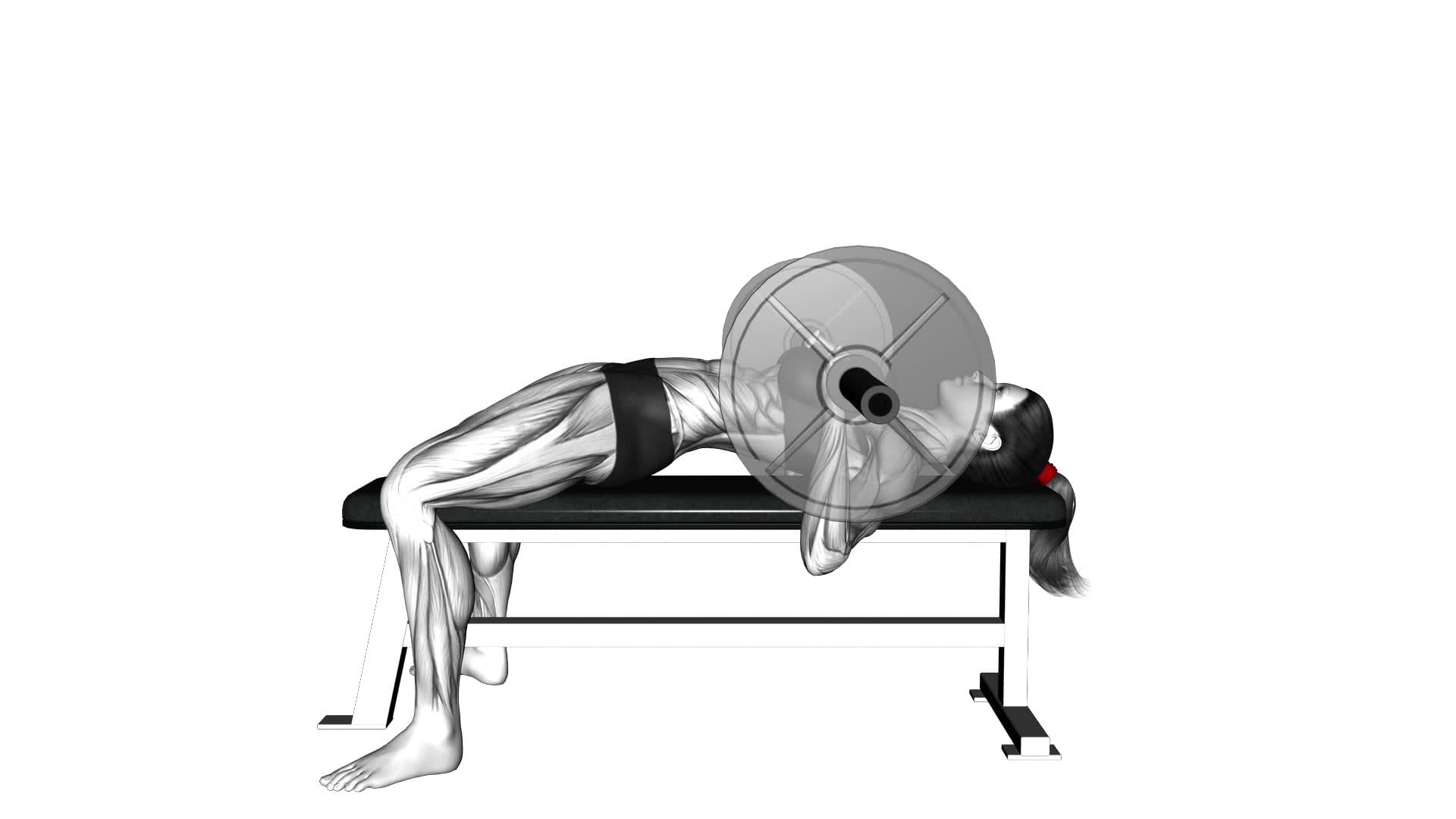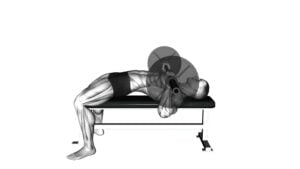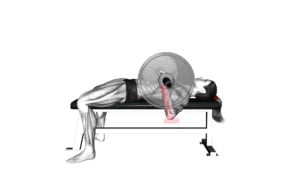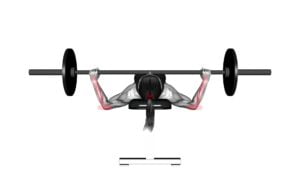Barbell Chest Bench Press – Butt (WRONG RIGHT) (female) – Video Exercise Guide & Tips

Are you a female looking to perfect your barbell chest bench press?
Watch This Exercise Video
In this video exercise guide, we'll show you the common mistakes in butt positioning and the correct alignment for females. Understanding the importance of hip placement is key to maintaining proper form.
We'll provide you with helpful tips and demonstrate both incorrect and correct butt positioning.
Get ready to level up your bench press game with this informative and concise video guide.
Key Takeaways
- Proper butt positioning is crucial in the barbell chest bench press exercise to avoid common mistakes and prevent injury.
- Females should aim to keep their butt firmly planted on the bench throughout the exercise while maintaining a flat back and relaxed shoulders.
- Engaging the core muscles and maintaining a neutral spine helps to stabilize the body and avoid unnecessary strain on the lower back.
- It is important to focus on hip placement and engage the glute muscles to generate more power and force through the legs. Incorporating hip mobility exercises into warm-up routines can be beneficial.
Common Mistakes in Butt Positioning
To avoid common mistakes in butt positioning during the barbell chest bench press, make sure that you keep your butt firmly planted on the bench throughout the exercise. Proper technique is crucial in order to avoid injury and maximize the effectiveness of the exercise.
One common mistake is lifting your hips off the bench as you lower the barbell. This not only compromises your form but also puts unnecessary strain on your lower back. To prevent this, engage your core muscles and press your lower back into the bench.
Another mistake is sliding your butt forward on the bench. This can happen when you're using too much weight or if your feet aren't firmly planted on the ground. To maintain proper alignment, make sure that your feet are flat on the floor and your knees are bent at a 90-degree angle.
Lastly, avoid arching your back excessively during the bench press. This can lead to lower back pain and potential injury. Instead, focus on keeping your back flat against the bench and your core engaged.
By avoiding these common mistakes in butt positioning, you can ensure that you're performing the barbell chest bench press with proper technique and minimizing the risk of injury.
Now let's move on to discussing the correct alignment for females during this exercise.
Correct Alignment for Females
Maintain proper alignment for females during the barbell chest bench press by ensuring that your butt remains firmly planted on the bench throughout the exercise. It's important to address common misconceptions and provide tips for beginners to help them achieve correct alignment and maximize the effectiveness of their workout.
One common misconception is that lifting your butt off the bench during the exercise can help you lift more weight. However, this is incorrect and can lead to injury. Keeping your butt firmly planted on the bench provides stability and ensures that you're engaging the correct muscles.
To maintain proper alignment, start by positioning yourself on the bench with your feet flat on the ground and your knees at a 90-degree angle. Your back should be flat against the bench, and your shoulders should be relaxed. Grip the bar with your hands slightly wider than shoulder-width apart.
As you lower the bar towards your chest, focus on keeping your butt in contact with the bench. Your butt shouldn't lift off or slide towards the edge of the bench. This will help you maintain stability and engage your chest muscles effectively.
For beginners, it can be helpful to start with lighter weights to practice proper alignment before progressing to heavier weights. Additionally, working with a trainer or experienced spotter can provide guidance and ensure that you're maintaining proper form throughout the exercise.
Understanding the Importance of Hip Placement
To ensure proper alignment and maximize the effectiveness of your barbell chest bench press, it's crucial to understand the importance of placing your hips correctly. Proper hip placement not only helps maintain stability but also allows for optimal engagement of the glute muscles during the exercise. Engaging the glutes is important because they play a significant role in stabilizing the pelvis and supporting the lower back.
When your hips are correctly positioned, you can generate more power and force through your legs, which translates into a stronger bench press. To improve hip mobility and ensure proper placement, incorporate hip mobility exercises into your warm-up routine. These exercises can help increase flexibility and range of motion in the hip joints, allowing for better movement during the bench press.
Some effective hip mobility exercises include hip circles, leg swings, and hip flexor stretches. Performing these exercises regularly can help improve your ability to maintain proper hip placement during the barbell chest bench press. Remember to focus on engaging your glutes throughout the entire movement to maximize the benefits of your workout.
Understanding the importance of hip placement is essential for achieving optimal results from your barbell chest bench press. By engaging your glutes and improving hip mobility, you can enhance your overall strength and stability, leading to better performance and reduced risk of injury. So, take the time to incorporate hip mobility exercises into your routine and reap the benefits of a properly aligned bench press.
Tips for Maintaining Proper Form
To ensure you maintain proper form during the barbell chest bench press, it's important that you focus on your breathing technique. Proper breathing can help stabilize your core and provide you with the necessary strength and stability to perform the exercise correctly. Here are some tips to help you maintain proper form:
- Maintain a neutral spine: Keep your back flat against the bench and avoid arching or rounding your lower back. This will help prevent unnecessary strain on your spine and maintain proper alignment.
- Engage your core: Contract your abdominal muscles throughout the exercise to provide stability and support to your spine. This will help maintain proper form and prevent any excessive movement.
- Keep your feet planted: Ensure that your feet are firmly planted on the ground throughout the exercise. This will provide a solid base of support and help stabilize your body.
- Focus on your glutes: Contrary to common misconceptions, the bench press isn't just an upper body exercise. Engage your glutes by squeezing them together throughout the movement. This will help activate your posterior chain and provide additional stability.
By following these tips, you'll be able to maintain proper form and get the most out of your barbell chest bench press.
Now, let's transition into the next section, where we'll discuss the video demonstration of incorrect butt positioning during this exercise.
Video Demonstration of Incorrect Butt Positioning
When it comes to the barbell chest bench press, proper alignment of your butt is crucial for maintaining proper form. However, there are common mistakes that people make when it comes to their butt positioning during this exercise.
Proper Butt Alignment
Align your butt properly during the barbell chest bench press to ensure correct form and prevent injury. Here are some tips to help you achieve proper butt alignment:
- Avoid the common misconception of sticking your butt up in the air. This can put unnecessary strain on your lower back and compromise your form.
- Engage your glutes by squeezing them together before and during the exercise. This will help activate the muscles and provide stability.
- Keep your butt in contact with the bench throughout the movement. This ensures that your lower back stays supported and reduces the risk of injury.
- Maintain a neutral spine by keeping your butt, lower back, and upper back in alignment. This promotes proper posture and allows for efficient muscle activation.
Common Butt Mistakes
Avoid the mistake of positioning your butt incorrectly during the barbell chest bench press by keeping it in contact with the bench at all times. One of the most common misconceptions is lifting your hips off the bench during the exercise. This can lead to injuries and decrease the effectiveness of the workout.
By keeping your butt in contact with the bench, you maintain stability and reduce the risk of straining your lower back. When your butt is off the bench, it puts unnecessary strain on your spine and can cause discomfort or even injury.
Remember to maintain proper form throughout the exercise to prevent injuries and maximize your gains.
Benefits of Correct Positioning?
To maintain proper form and avoid injury during the barbell chest bench press, it's crucial to position your butt correctly, keeping it in contact with the bench at all times. Many people have common misconceptions about the importance of butt positioning during this exercise, but understanding the benefits of correct positioning can greatly impact muscle activation and overall effectiveness.
Here are four key benefits of maintaining the correct butt position:
- Stability: By keeping your butt in contact with the bench, you create a stable base to push from, allowing you to generate more power and lift heavier weights.
- Proper Muscle Engagement: Correct butt positioning ensures that your glutes, hamstrings, and core muscles are activated, maximizing the effectiveness of the exercise and preventing excessive strain on other muscles.
- Spinal Alignment: Keeping your butt in contact with the bench helps maintain proper spinal alignment, reducing the risk of injury and promoting a strong and stable posture.
- Full Range of Motion: Correct butt positioning allows for a full range of motion in the exercise, ensuring that your chest muscles are fully engaged and developed.
Understanding these benefits will help you optimize your barbell chest bench press. Now, let's move on to the video demonstration of correct butt positioning.
Video Demonstration of Correct Butt Positioning
Find the right position for your butt during the barbell chest bench press by watching this video demonstration. Many people have common misconceptions about butt positioning during this exercise, but with the proper technique, you can improve your form and maximize your results.
In the video, you'll see a step-by-step guide on how to position your butt correctly. The trainer emphasizes the importance of keeping your butt in contact with the bench throughout the exercise. This ensures that you maintain stability and engage the correct muscles.
To achieve the correct butt positioning, start by sitting at the edge of the bench with your feet firmly planted on the ground. Slowly lie back, keeping your butt in contact with the bench. Your lower back should be slightly arched, and your shoulder blades should be squeezed together.
Throughout the exercise, focus on keeping your butt firmly on the bench and avoid lifting or bouncing it off. This helps to maintain proper form and prevents strain on your lower back.
Frequently Asked Questions
How Can I Modify the Barbell Chest Bench Press Exercise for Pregnant Women?
To modify the barbell chest bench press exercise for pregnant women, it's important to prioritize their safety and comfort. Avoid lying flat on your back, as this can restrict blood flow to the baby. Instead, prop yourself up with pillows or use an incline bench.
Reduce the weight and focus on maintaining proper form. Always listen to your body and consult with a healthcare professional for specific modifications and safety precautions during pregnancy.
What Are Some Common Mistakes to Avoid When It Comes to Hip Placement During the Barbell Chest Bench Press?
When it comes to hip placement during the barbell chest bench press, there are some common mistakes to avoid.
One mistake is letting your butt lift off the bench, which can put strain on your lower back.
Another mistake is arching your back too much, which can lead to improper form and potential injury.
It's important to maintain a stable and neutral hip position throughout the exercise.
Pregnant women can modify the barbell chest bench press by using a stability ball or performing floor presses instead.
Are There Any Specific Cues or Tips to Help Engage the Glutes More Effectively During This Exercise?
When it comes to engaging your glutes more effectively during the barbell chest bench press, there are a few cues and tips you can incorporate.
First, focus on maintaining a stable hip position throughout the exercise. Engage your glutes by squeezing them together and pressing your hips into the bench.
Additionally, you can try using a hip thrust technique, where you drive your hips up towards the ceiling as you perform the bench press. This will help activate your glutes and increase their engagement during the exercise.
Can I Use Dumbbells Instead of a Barbell for the Chest Bench Press Exercise?
Yes, you can definitely use dumbbells instead of a barbell for the chest bench press exercise. Using dumbbells allows for more range of motion and can help target different areas of the chest muscles. It also helps to engage the stabilizer muscles more effectively.
You can try variations of bench press, like incline or decline bench press, to further target specific areas of the chest. Remember to maintain proper form and start with lighter weights before progressing to heavier ones.
How Often Should I Incorporate the Barbell Chest Bench Press Into My Workout Routine for Optimal Results?
To achieve optimal results, it's important to incorporate the barbell chest bench press into your workout routine with the right frequency.
The barbell chest bench press is a compound exercise that targets your chest muscles.
Aim to perform this exercise at least twice a week, allowing for adequate rest and recovery between sessions.
Additionally, you can vary your workout by trying different exercise variations, such as incline or decline bench press, to target different areas of your chest muscles.
Conclusion
In conclusion, maintaining proper butt positioning during a barbell chest bench press is crucial for females. Incorrect alignment can lead to inefficient muscle engagement and potential injuries.
Understanding the importance of hip placement and following the correct alignment guidelines is essential for maximizing the benefits of this exercise. By practicing proper form and using the tips provided, females can enhance their performance and reduce the risk of injury.
Watch the video demonstrations to ensure you're positioning your butt correctly for optimal results.

Author
Years ago, the spark of my life’s passion ignited in my mind the moment I stepped into the local gym for the first time. The inaugural bead of perspiration, the initial endeavor, the very first surge of endorphins, and a sense of pride that washed over me post-workout marked the beginning of my deep-seated interest in strength sports, fitness, and sports nutrition. This very curiosity blossomed rapidly into a profound fascination, propelling me to earn a Master’s degree in Physical Education from the Academy of Physical Education in Krakow, followed by a Sports Manager diploma from the Jagiellonian University. My journey of growth led me to gain more specialized qualifications, such as being a certified personal trainer with a focus on sports dietetics, a lifeguard, and an instructor for wellness and corrective gymnastics. Theoretical knowledge paired seamlessly with practical experience, reinforcing my belief that the transformation of individuals under my guidance was also a reflection of my personal growth. This belief holds true even today. Each day, I strive to push the boundaries and explore new realms. These realms gently elevate me to greater heights. The unique combination of passion for my field and the continuous quest for growth fuels my drive to break new ground.







